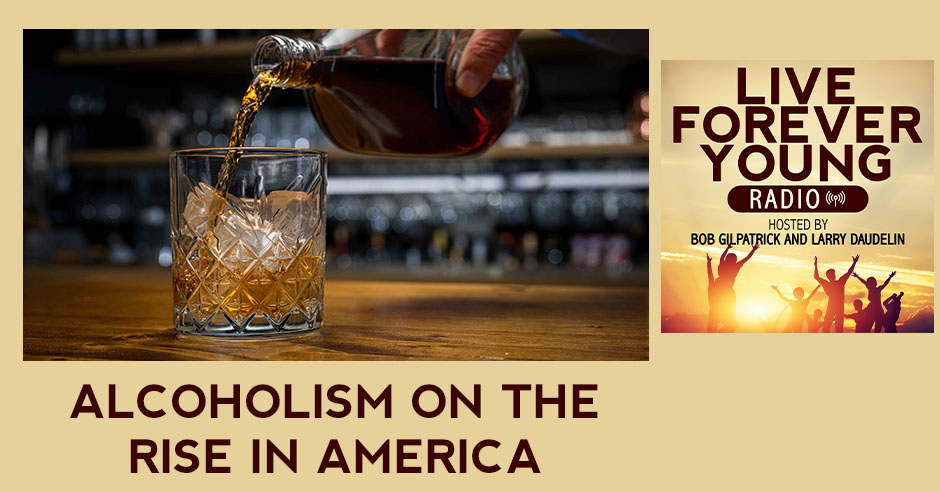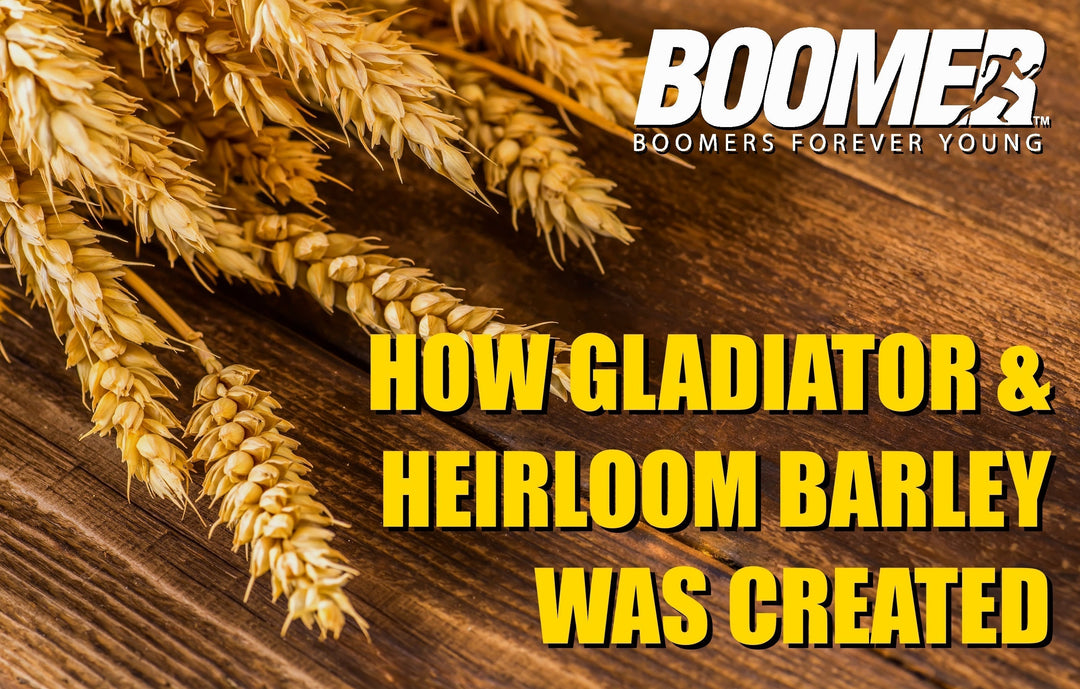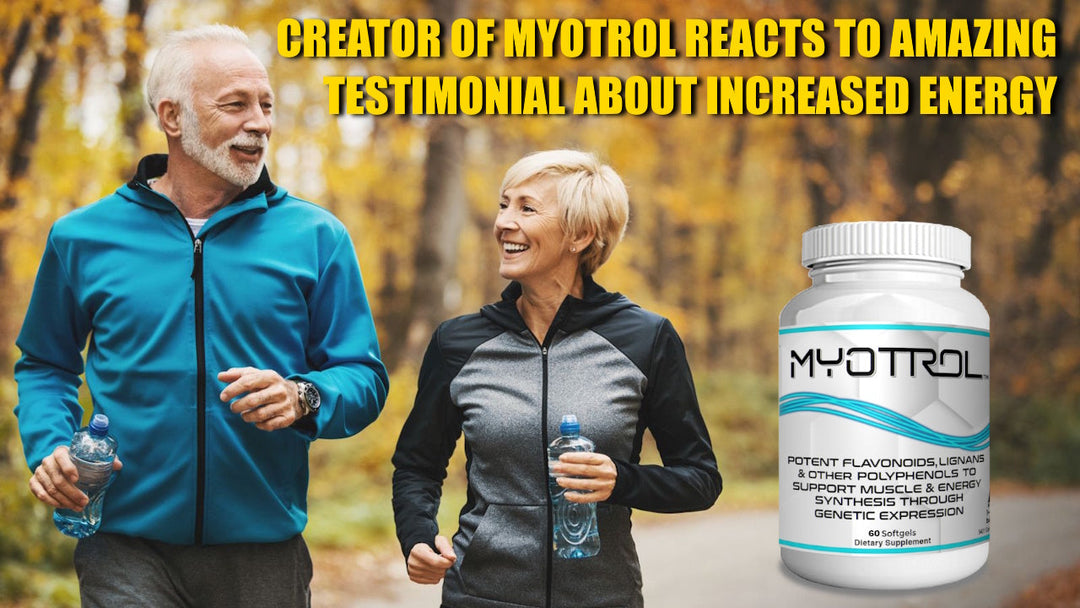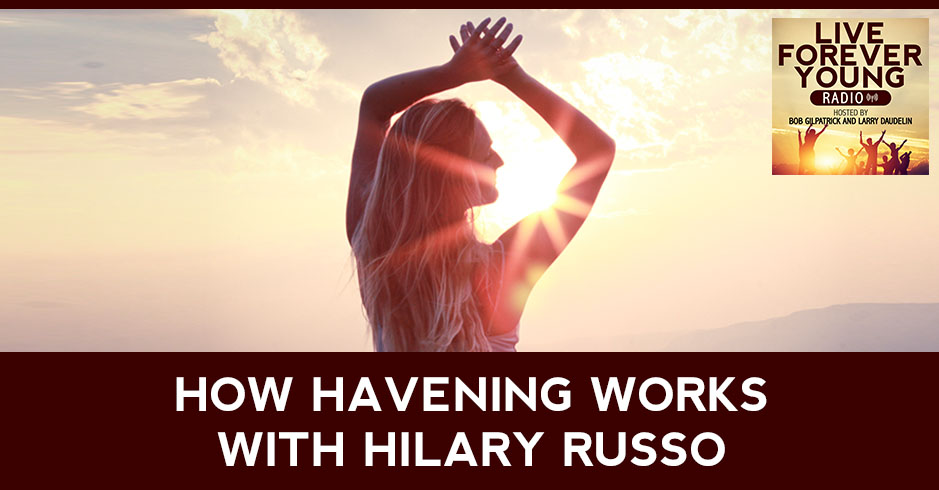Alcoholism On The Rise In America

Deaths involving alcohol abuse increased sharply during the pandemic. Particularly in young people, where 1 in 5 deaths in the 20-49 age group are now related to alcohol.
The isolation caused by the pandemic is one of the major driving factors in this recent rise in alcohol related deaths, but what other factors are to blame?
On the show today, Bob Gilpatrick and Larry Daudelin discuss other changes in society throughout history that have helped to speed up the pace of alcoholism in America. They also share some real, actionable ways to start breaking the habit of alcoholism and improve relationships with loved ones at the same time.
So sit back, relax, and get ready to live forever young.
Watch the Show Here:
Alcoholism On The Rise In America
Thanks for reading the show. Deaths involving alcohol abuse increased sharply during the pandemic, particularly in young people, where 1 in 5 deaths in the 20 to 49 age group is related to alcohol. The isolation caused by the pandemic is one of the major driving factors in this recent rise in alcohol-related deaths. What other factors are to blame?
On the show, Bob and Rollie discuss other changes in society throughout history that have helped to speed up the pace of alcoholism in America. They also share some real actionable ways to start breaking the habit of alcoholism and improving relationships with loved ones at the same time. Sit back, relax and get ready to live forever young.
---
Rollie, how are you?
Good, Bob. How are you?
Doing well, thank you. Sometimes when we do an episode, we have to talk about some things that are a little bit uncomfortable, things that have some negativity associated with them Towards the end of what we're going to talk about, we'll be able to turn it towards the positive and give some great solutions to this issue we're going to discuss, which is alcoholism.
We decided to talk about it because with COVID and people being isolated a lot more over the last few years, we've seen a real rise in deaths from excessive alcohol consumption.
Especially with younger people. If you take the age group of 20 up to 49 or 50, 1 in 5 times when someone dies young in that age bracket, they're dying from alcoholism. What that means is it could be from an automobile accident, alcohol poisoning, a fall or disease, whether it's your pancreas or liver. Those are the types of issues that cause early death.
Compounds in isolation also lead to suicide. One of the main ones that go along with excessive alcohol consumption is suicide. You're lonely. You're feeling desperate and destitute. You turn to the bottle and you've noticed that's another one.
The problem is death is the ultimate problem. Alcoholism also leads to a lot of missed opportunities, both for society in regard to businesses that have poor attendance from people that are using alcohol or they show up on Monday morning after drinking over the whole weekend. They're not very productive. You also have issues with relationships that break up because of alcoholism. There's a lot of societal damage and personal suffering that occurs from too much alcohol.
On the news, it's weird. I heard this new term. They're talking about social jet lag, where you stay up too late and you have too good of a time on the weekend. They refer to it as social jet lag. You come in on Monday morning. You're hungover and you're not productive at work. That's one of the things. The ultimate that's been on rise is that these deaths have been increasing.
Part of what's contributed to this also is not just COVID. There was a turn of events many years ago, whereas prior to that, people were drinking beer and wine mostly. You had around 2% to 3% alcohol for beer. The wine was 10%, maybe a max of 13%. That went on going back many years ago when the first evidence was that people were drinking fermented beverages. There's even a theory that the whole reason agriculture was created was to grow more grain to make more alcohol.
 Alcoholism In America: There is a theory that says that the whole reason agriculture was created was to grow more grain to make more alcohol.[/caption]
Alcoholism In America: There is a theory that says that the whole reason agriculture was created was to grow more grain to make more alcohol.[/caption]
I guess it got the Industrial Revolution going.
No definite proof of that but that's a theory. There's some evidence that shows that that's what happened.
Before The Industrial Revolution and the actual bottling process, beer was a local thing. You had to have a brewery in your town. Taking fermented beer and trying to ship it at that time, they had no cold rail cars. There was no way to take these fermented drinks and get them anywhere but in the little town where they were made.
The only way they did it was with the British Empire where they would put beer in these barrels. They were stripping it to places like India, which they had invaded, to give their soldiers beer. That's where the whole IPA came from. It was India pale ale. They were sending barrels and the beer would go bad if they didn't coat the top of the barrel with hops. When it arrived in India, it was a very hoppy-tasting beer. The soldiers didn't like it at first but then they started to gain a preference for it.
Later when they got back to England, they were like, "Where's the beer with the hops?" Thus was born India pale ale. A lot of what happens is people go to these craft beer places and that's the most popular beer. Many years ago was approximately when distillation was created and that gave us the onset of harder liquors, which are now 30% up to 90% alcohol. Just a small shot of a drink of something like vodka, tequila or whiskey had the equivalent amount of alcohol of a whole beer or a whole glass of wine. That led to an escalation in people spending more time drunk and more abuse of alcohol with this cultural change that we've seen in the United States.
Craft breweries and things like that. Craft cocktails. One of the things that they also have relied on, even in commercial drinks, is adding flavors and sugars to seltzer water. You've got seltzer water that's highly alcoholic and then they add sugar to it. It's absorbed easily and creates a lot of inflammation and adds to the whole problem and the addiction, the sugar and the alcohol together. It's not good.
You have the rise of these delivery services.
You could sit at home and dial.
You hear commercials on the radio saying, "Give us a call and we'll bring all the booze you want to your house. It's less expensive than at the liquor store. You don't have to wait in line. Call us and we'll deliver it."
That's one of the side effects of COVID. Remember that these delivery companies got popular when you couldn't go to the store. We were too scared to go to the store or we didn't want to be exposed. We got used to it. Even here in Florida where we're at, they allowed restaurants. They passed a to-go thing where you could sell to-go drinks.
This further created isolation.
You don't have to go to the bar.
When people are isolated, they tend to get depressed and cover their troubles with alcohol. These are the things that have contributed to what we're seeing where 1 in 5 deaths are the result of alcohol.
That's 20%. That's high.
The other thing is it occurs when people drink too much. It's been well-known for a long time. You tend to get malnourished. If you're going to consume 2,500 calories a day and 1,200 or 1,500 of them are from alcohol, you don't have enough room in your stomach to eat enough food to be well-nourished. People suffer from the problems of malnourishment. A lot of it is becoming overweight. You're malnourished so you crave more food. You're drinking this amount of alcohol, plus you're craving food. The next thing you know, you've gained 50 pounds and you're at risk for all different types of diseases beyond what you would be at risk for with just the alcohol.
That's a double-edged sword. You drink and then you want to eat. Not only is the drinking bad but then you gain weight and other things from eating, drinking and the excess excessive sugars. You've got a double whammy. Not only are you eligible to have problems from alcohol but you have heart problems or whatever other problem.
Risk for stroke, dementia and diabetes. One of the things we know is that one of the biggest problems for people who are drinking is it affects their liver negatively. People will tend to retain fat in their livers. They get fatty liver on top of the cirrhosis, which causes this scarring and plaques in the liver that is from the alcohol itself.
 One of the things that can help is a compound that you make in your body. It's called phosphatidylcholine. It helps to extract the fat out of your liver and allow it to be burned for fuel. That's a good protective compound. There's another one called acetylcysteine, which is also very protective. We made sure that both of those compounds were in our Boomer Boost product.
One of the things that can help is a compound that you make in your body. It's called phosphatidylcholine. It helps to extract the fat out of your liver and allow it to be burned for fuel. That's a good protective compound. There's another one called acetylcysteine, which is also very protective. We made sure that both of those compounds were in our Boomer Boost product.
Not specifically for that reason but for many reasons. It just so happens that if people use Boomer Boost, which has 70 nutrients in it, including those 2 compounds, they're going to be much healthier overall because they'll be well-nourished, as opposed to malnourished. They also have those two important compounds that create a healthier liver.
You read my mind. If you're malnourished, one of the things that Boomer Boost does is help replenish your essential nutrients, vitamins, minerals, specialty nutrients, coenzymes and things like that. Some of these special nutrients are phosphatidylcholine and acetylcysteine. You've got these nutrients to help cover your fundamentals of nutrition. They also have these other properties that can help with things like fatty liver and all these issues.
The fact that 70 different ingredients are there in one kind of drink is great because you get the fundamentals of nutrition that every body needs. You also get these awesome, great benefits of other things like phosphatidylcholine and all these other specialty nutrients that we have. That's why it was designed that way. To give you everything you can't get from a regular diet, especially if you're malnourished from alcoholism.
Rollie, one other thing, we've done a whole show on this, is the technique called havening. It helps deal with issues, especially issues related to your past. Some people begin drinking at an early age because of things that are going on in their childhood. It just gets carried forward as a habit and they never deal with the issues of their childhood.
Havening is a technique that helps with that. It was written by a medical doctor. The book called When the Past Is Always Present. He created this technique where you rub your hands together and repeat certain phrases that help you deal with issues from your past so that you can live instead in the present moment with joyful anticipation for the future. Instead of dread of things from the past.
We did a show called The Power of Touch. We go into detail on its history of it. How it was created, when it was created and some of the people who were behind it. It’s an amazing technique for helping with things like this.
There’s another thing we find because of the issue of isolation and what we learned from the author of When the Past Is Always Present. What he was saying is that he used to run these alcohol treatment centers and people would voluntarily come. After a couple of days, they would leave. The reason was they had anxiety, which had led to the drinking, to begin with. When they took away the alcohol, after a couple of days, the anxiety got so high that they would have to leave. Havening was created to reduce that anxiety.
When the Past Is Always Present: Emotional Traumatization, Causes, and Cures
Another thing that we know helps is when people have meaningful goals that they can do at the moment and focus on. That will give them a positive result in the future. We know that people should write down their goals. Pick one goal that you have that you can focus on and then make an action step. Take that first step and have a list of the steps that you need to begin to achieve this goal. Motion and action create progress toward that goal.
If you can keep your mind focused on those continuous action steps, you're going to discover at some point, "This is a challenge because this is something new I'm moving towards." That's good because a challenge forces you to create new skills for yourself which makes you feel good about yourself. It creates a brand-new capability as you take that challenge.
Usually, there's a difference in skill level between what someone has at the beginning of pursuing a goal and the skill they need to accomplish the goal. It's in that process of challenging yourself that creates this new capacity that will allow you to accomplish that goal. Every step along the way where you take an action step, you want to celebrate. We did a whole episode on habits.
How to build tiny habits and meaningful habits. One of the things that we talk about that is a real key is celebrating a win. It's like in a sports team, you do something great and celebrate. You don't have to do a touchdown celebration dance but you can do one. That's the kind of thing that reinforces the work that you're putting in.
There’s one thing I was thinking about when you're talking about these action steps. One of the hardest things is to get going, to start. Taking small action steps can help you build the momentum to see your way through to get to that meaningful goal. It's hard to take one big giant step all at one time because you don't have any momentum.
If you start taking tiny steps and build that momentum up to achieving your goal, then that's one of the things that you can use to reach it. Don't worry about trying to get everything done in one day because you're more than likely not going to get everything done in one day. You have to take small action steps to build momentum and then achieve that goal.
Make it a habit. Two things that people can do. Read The Power of Touch episode. This helps you create a clean slate where you can resolve issues from your past so that you're not being negatively affected in the present moment. That gives you this clean slate to create the life that you want. Look at the episode on Tiny Habits. Use that technique to get into the habit of taking these steps that will lead to your goal.
We're focusing our efforts, challenging ourselves and building a new capacity.
The desire is for doing the following things, people that might be having issues with too much alcohol or know somebody that is, we can use the information from this and those other two episodes, perhaps to save someone's life.
We talk to people all the time who say, "If you guys hadn't shown me this, the tapping or the havening, I might still be in the same spot I was. I'm glad I'm not there." Go check them out, BoomerBoost.com. Check out all our old episodes. Go to our YouTube. We're on TikTok too so check us out there. We'll be doing lives there where we'll come on and talk to you live, real-time, where we can take questions.
If you haven't seen us on TikTok or you're not on TikTok, go check out TikTok. It's got this cool feature where we can go live and talk directly to you. We're going to be doing some of that soon. Keep an eye out for us on that. Apart from that, I'm glad we went over what we went over.
Thank you, everybody, for reading. We'll see you in the next episode.
Important Links
- Boomer Boost
- When the Past Is Always Present
- The Power of Touch – Past Episode
- Tiny Habits – Past Episode
- YouTube – Boomers Forever Young






Leave a comment